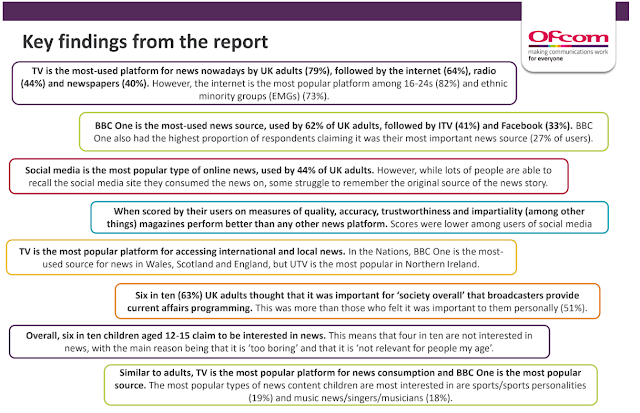Newspapers: The decline in print media- Ofcom report into news consumption 2018
Now read this Ofcom 2018 report on the consumption of news in the UK. Note down the key statistics and changes that Ofcom highlight and answer the following questions:
1) Look at the key findings from the report on page 2. How do UK adults generally get their news?

TV is the most popular platform amongst 79% of UK adults in finding news. This is followed by the internet at 64%. However, the internet is the most popular platform amongst young adults aged 16-24 (82%) and ethnic minority groups (73%).
2) Read the overall summary on page 8. How popular are newspapers as a news source? How does this compare to other news sources?
From the summary on page 8, newspapers don't seem popular at all compared to other platforms. Eight in ten (82%) of those aged 16-24 use the internet for news nowadays, compared to just six in ten (57%) that use TV, while for EMGs, 73% use the internet for news and 69% use TV. However, the report does state that 'Those aged 65+ are more likely than 16-24s to use all platforms for news, except for the internet, and TV news use among this age group is almost ubiquitous (94%). This shows how newspapers are prefered by older people rather than a younger readership that would prefer modern methods.
3) Look at the summary of platforms used on page 13. What audience demographic groups are most and least likely to read newspapers?

65+ year olds are more likely to read printed newspapers than any other demographic (60%)
16-24 year olds are least likely to read printed newspapers (only 21% use it as their main news source)
4) Read Section 3 on cross-platform news consumption (page 19). What newspaper brands can you find in the list of most popular news sources across platforms?
BBC One
ITV
Facebook
The BBC News Channel
Sky News Channel
Overall, BBC One is the most popular news source at 62%.
5) Now turn to Section 6 focusing on newspapers (page 38). How has the circulation of national newspapers decreased since 2003?
Circulation of national newspaper titles has decreased from almost 30 million in 2003 to 12.4 million in 2017. So it has decreased by 17.6 million (more than half)
6) What are the most-used newspaper titles?
Daily Mail (31%)
Metro (23%)
7) What newspaper are 65+ people more likely to read?
Daily Mail
The Mail on Sunday
8) What are the most popular titles when print and online figures are combined (look at page 41)?
Daily Mail (8,409)
Guardian (6,740)
Metro (6,737)
9) How does the i compare to the Daily Mail?
The 'i' is much lower in terms of the most used title compared to the Daily Mail. (2,166 VS The Daily Mail's 8,409)
10) Look at page 42. What percentage of newspaper users used free newspapers such as Metro in the UK in 2018 ('freesheets')?
26% of newspaper users used daily ‘free-sheets'
11) Now study the demographic details for our two CSP newspapers on page 44. What is the breakdown of the Daily Mail audience?
Daily Mail
Total- 31%
Male- 29%
Female- 32%
16-24- 22%
65+- 37%
ABCI- 31%
C2DE- 30%
EMG- 31%
NON-EMG- 31%
12) What is the breakdown for the i audience?
The i
Total- 5%
Male- 7%
Female- 4%
16-24- 11%
65+- 5%
ABCI- 7%
C2DE- 4%
EMG- 4%
Non-EMG- 6%
13) Look at the summary on page 46: news consumption via social media. What audience groups are using social media for their news and what sites do they use?
More than two fifths (44%) of adults claim to consume news via social media.
• Of these, three quarters (76%) claim to use Facebook for news nowadays, followed by Twitter (32%), then WhatsApp (22%) and Instagram (21%).
14) What does this report tell us about the decline of the traditional newspaper industry in the UK?
This report confirms the fact that the decline of the traditional newspaper has to do with the rise of technology, the internet and social media. People use the TV, internet and social media to hear about the news over newspapers. Furthermore, the people who are most likely to read newspapers are 65+-year-olds and this is probably due to the fact that they grew up in a generation where there was no other way to learn about the news so they are used to it.
15) How can media institutions such as the Daily Mail and the i remain relevant and profitable in the digital media landscape?
They can remain relevant and profitable by producing quality journalism and posting daily on all media platforms.
1) Look at the key findings from the report on page 2. How do UK adults generally get their news?

TV is the most popular platform amongst 79% of UK adults in finding news. This is followed by the internet at 64%. However, the internet is the most popular platform amongst young adults aged 16-24 (82%) and ethnic minority groups (73%).
2) Read the overall summary on page 8. How popular are newspapers as a news source? How does this compare to other news sources?
From the summary on page 8, newspapers don't seem popular at all compared to other platforms. Eight in ten (82%) of those aged 16-24 use the internet for news nowadays, compared to just six in ten (57%) that use TV, while for EMGs, 73% use the internet for news and 69% use TV. However, the report does state that 'Those aged 65+ are more likely than 16-24s to use all platforms for news, except for the internet, and TV news use among this age group is almost ubiquitous (94%). This shows how newspapers are prefered by older people rather than a younger readership that would prefer modern methods.
3) Look at the summary of platforms used on page 13. What audience demographic groups are most and least likely to read newspapers?

65+ year olds are more likely to read printed newspapers than any other demographic (60%)
16-24 year olds are least likely to read printed newspapers (only 21% use it as their main news source)
4) Read Section 3 on cross-platform news consumption (page 19). What newspaper brands can you find in the list of most popular news sources across platforms?
BBC One
ITV
The BBC News Channel
Sky News Channel
Overall, BBC One is the most popular news source at 62%.
5) Now turn to Section 6 focusing on newspapers (page 38). How has the circulation of national newspapers decreased since 2003?
Circulation of national newspaper titles has decreased from almost 30 million in 2003 to 12.4 million in 2017. So it has decreased by 17.6 million (more than half)
6) What are the most-used newspaper titles?
Daily Mail (31%)
Metro (23%)
7) What newspaper are 65+ people more likely to read?
Daily Mail
The Mail on Sunday
8) What are the most popular titles when print and online figures are combined (look at page 41)?
Daily Mail (8,409)
Guardian (6,740)
Metro (6,737)
9) How does the i compare to the Daily Mail?
The 'i' is much lower in terms of the most used title compared to the Daily Mail. (2,166 VS The Daily Mail's 8,409)
10) Look at page 42. What percentage of newspaper users used free newspapers such as Metro in the UK in 2018 ('freesheets')?
26% of newspaper users used daily ‘free-sheets'
11) Now study the demographic details for our two CSP newspapers on page 44. What is the breakdown of the Daily Mail audience?
Daily Mail
Total- 31%
Male- 29%
Female- 32%
16-24- 22%
65+- 37%
ABCI- 31%
C2DE- 30%
EMG- 31%
NON-EMG- 31%
12) What is the breakdown for the i audience?
The i
Total- 5%
Male- 7%
Female- 4%
16-24- 11%
65+- 5%
ABCI- 7%
C2DE- 4%
EMG- 4%
Non-EMG- 6%
13) Look at the summary on page 46: news consumption via social media. What audience groups are using social media for their news and what sites do they use?
More than two fifths (44%) of adults claim to consume news via social media.
• Of these, three quarters (76%) claim to use Facebook for news nowadays, followed by Twitter (32%), then WhatsApp (22%) and Instagram (21%).
14) What does this report tell us about the decline of the traditional newspaper industry in the UK?
This report confirms the fact that the decline of the traditional newspaper has to do with the rise of technology, the internet and social media. People use the TV, internet and social media to hear about the news over newspapers. Furthermore, the people who are most likely to read newspapers are 65+-year-olds and this is probably due to the fact that they grew up in a generation where there was no other way to learn about the news so they are used to it.
15) How can media institutions such as the Daily Mail and the i remain relevant and profitable in the digital media landscape?
They can remain relevant and profitable by producing quality journalism and posting daily on all media platforms.




Comments
Post a Comment